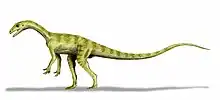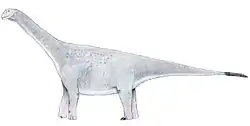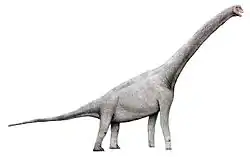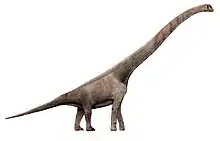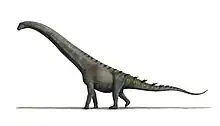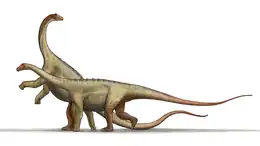Pampadromaeus
Pampadromaeus is an extinct genus of basal sauropodomorph dinosaurs known from the Late Triassic (Carnian) Santa Maria Formation of the Paraná Basin in Rio Grande do Sul, southern Brazil.[1]
| Pampadromaeus | |
|---|---|
 | |
| Skeletal reconstruction showing known remains | |
| Scientific classification | |
| Domain: | Eukaryota |
| Kingdom: | Animalia |
| Phylum: | Chordata |
| Clade: | Dinosauria |
| Clade: | Saurischia |
| Clade: | †Sauropodomorpha |
| Family: | †Saturnaliidae |
| Genus: | †Pampadromaeus Cabreira et al. 2011 |
| Species: | †P. barberenai |
| Binomial name | |
| †Pampadromaeus barberenai Cabreira et al. 2011 | |
Discovery
Pampadromaeus is known only from the holotype specimen ULBRA-PVT016, a disarticulated, partial but well preserved skeleton from a single individual which includes most of the skull bones and the lower jaws; dorsal, sacral and caudal vertebrae; elements of the shoulder girdle and the forelimbs, an ilium and elements of the hindlimbs. It was collected in the upper Hyperodapedon biozone from the Alemoa Member of the Santa Maria Formation (Rosário do Sul Group) in the "Janner" (also known as "Várzea do Agudo") locality, geopark of Paleorrota, dating to the Carnian faunal stage of the early Late Triassic, about 230–228 million years ago.[1] A U-Pb (uranium decay) dating found that the Santa Maria Formation dated around 233.23 million years ago, putting it 1.5 million years older than the Ischigualasto Formation, and making the two formations approximately equal as the earliest dinosaur localities.[2]
Description
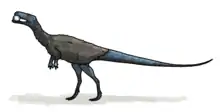
Pampadromaeus was a small bipedal animal. It shows a mosaic of basal and derived traits. It differs from other sauropodomorphs by a combination of characters. Some of these are shared with members of the Theropoda: the premaxilla is pointed downwards forming a subnarial gap with the maxilla and the anterior-most teeth are unserrated; in the location where with theropods the fenestra promaxillaris is positioned, a small depression is present. Basal traits consist of a large skull, a short thighbone, the possession of just two sacral vertebrae and the presence of fifteen teeth in the pterygoid.[1]
There were four teeth in the premaxilla and about twenty in both the maxilla and the lower jaw for a total of eighty-eight. The teeth were large, elongated, lanceolate, slightly recurved, sharply pointed and coarsely serrated. The lower leg was much longer than the thighbone, indicating a cursorial lifestyle.[1]
Etymology
Pampadromaeus was first named by Sergio F. Cabreira, Cesar L. Schultz, Jonathas S. Bittencourt, Marina B. Soares, Daniel C. Fortier, Lúcio R. Silva and Max C. Langer in 2011 and the type species is Pampadromaeus barberenai. The generic name is derived from Quechua pampa, "plain", in reference to the present landscape of the site, and Greek δρομεύς, dromeus, "runner", referring to the cursorial habits; the Latinised spelling variant dromaeus is used. The specific name honours the Brazilian paleontologist Mário Costa Barberena.[1]
Phylogeny
Pampadromaeus was found to be a basal sauropodomorph in four different cladistic analyses. The describers emphasized however, that this position was not strongly supported, showing the difficulties of determining the affinities of such early forms with the basal Dinosauromorpha, Saurischia, Sauropodomorpha and Theropoda.[1]
References
- Cabreira et al., 2011
- Langer et al., 2018
Bibliography
- Cabreira, Sérgio F.; Cesar L. Schultz; Jonathas S. Bittencourt; Marina B. Soares; Daniel C. Fortier; Lúcio R. Silva, and Max C. Langer. 2011. New stem-sauropodomorph (Dinosauria, Saurischia) from the Triassic of Brazil. Naturwissenschaften 98(12). 1035–1040. Accessed 2019-03-29.
- Langer, Max Cardoso; Blair Wayne McPhee; Júlio César de Almeida Marsola; Lúcio Roberto Da Silva, and Sérgio Furtado Cabreira. 2019. Anatomy of the dinosaur Pampadromaeus barberenai (Saurischia—Sauropodomorpha) from the Late Triassic Santa Maria Formation of southern Brazil. PLoS ONE 14. 1–64. Accessed 2019-03-29.
- Langer, M.C.; J. Ramezani, and Á.A.S. Da Rosa. 2018. U-Pb age constraints on dinosaur rise from south Brazil. Gondwana Research 53. 133–140. Accessed 2019-03-29.
